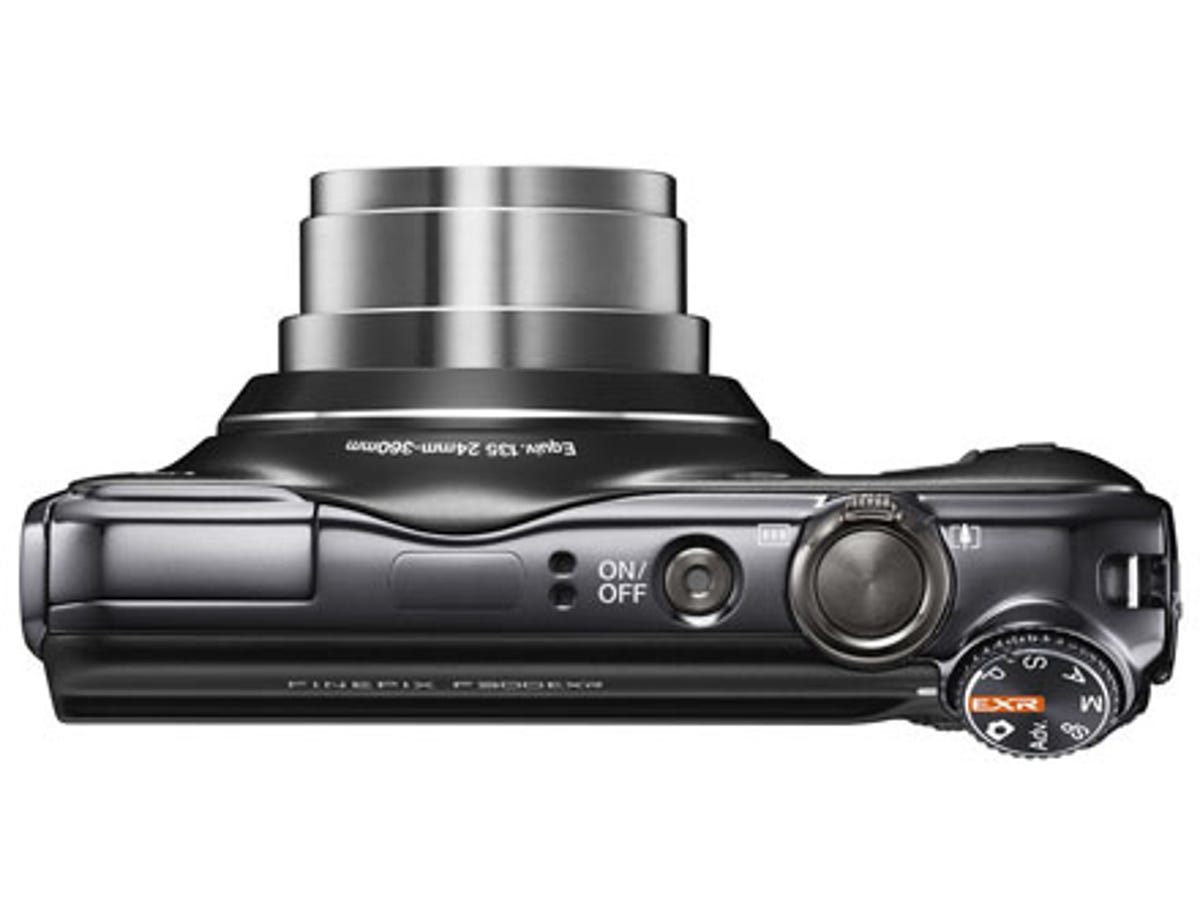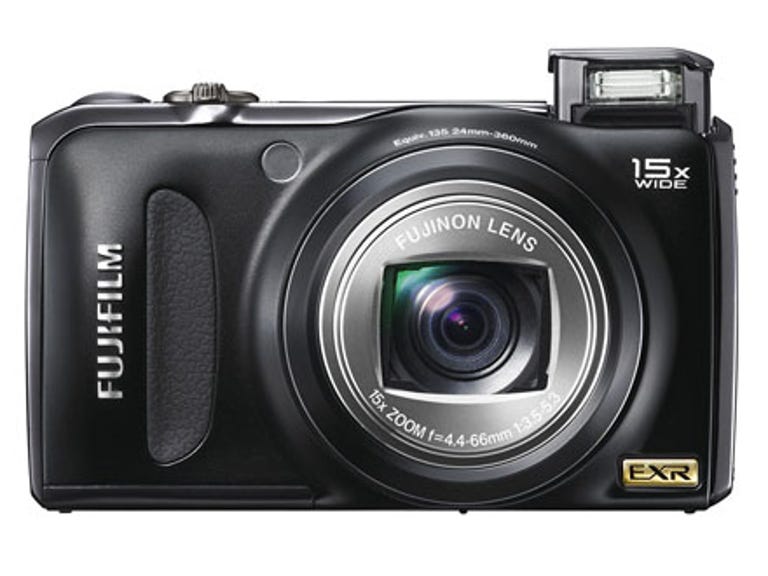 Why You Can Trust CNET
Why You Can Trust CNET Fujifilm FinePix F300EXR review: Fujifilm FinePix F300EXR
This camera's great zoom range, metal build and cracking LCD screen are occasionally let down by rather dull, listless images lacking in contrast. The Fujifilm FinePix F300EXR's noisy zoom and overly sensitive mic are also considerable pitfalls.
With its impressive headline spec of 15x optical zoom and 12 megapixels, combined with its sleek, undulating curves and pocket-friendly proportions, the £280 FinePix F300EXR suggests Fujifilm has regained its sense of purpose when it comes to digital compacts. And it's about time, too.
The Good
The Bad
The Bottom Line
Sensory pleasures
The F300EXR has a secret weapon up its digital sleeve. As indicated by its suffix, the F300 incorporates a Super CCD EXR sensor, and a second-generation one at that. For those not up to speed regarding the properties of said sensor, it can be utilised in one of three ways. There's a choice of shooting at full, 12-megapixel resolution in High Resolution (HR) mode, alternatively selecting wide Dynamic Range (DR) mode to balance shadows and highlights for tricky exposures, or opting for Low Noise (SN) mode for shooting without the flash in dimmer conditions. Can't decide? Then leave the camera on its default Auto EXR setting, which ably recognises a range of common scenes and subjects.
Metal gear solid
This seductive new 'travel zoom' makes its plasticky rival -- the 14x-zoom Canon PowerShot SX21 0IS, which retailed for nearly the same premium price on launch earlier this year -- resemble an uninspiring bar of soap in comparison.
With a high proportion of metal in its construction, Fujifilm's F300EXR feels solid when held. That said, there's not actually that much to grip onto, save for a gentle curve to the faceplate and thin rubber pad. Six tiny nodules at the back prove additional purchase for the thumb, next to a rotund bulge that incorporates a backward-sloping shooting mode dial. This dial features program, shutter priority, aperture priority and manual settings, plus scene position, regular auto, Auto EXR and advanced settings. The latter includes a new 360° motion panorama mode for a digital theatre effect that results in one sweeping, elongated image file. There's also a background-defocusing Pro Focus and noise-avoiding Pro Low Light mode. These work by combining several exposures, so a tripod is a must. If you haven't got one of those on hand, setting the self-timer and resting the camera on a flat surface does the job.

Fujifilm would maintain that the unusual positioning of the shooting dial makes for easier access to the essential settings. While this may very well be true, it looks like the dial has accidentally slipped from its ordinary top-plate position, giving the impression the right-hand side of the camera has wilted.
Switch the F300EXR on and there's an even more obvious annoyance. The built-in flash, usually tucked away neatly within the top plate, rises automatically and without request. Try as you might, there's no way to click it back down into place again. Consequently, it gets in the way of where you'd usually place your thumb when gripping the camera in both hands to line up a shot. The F300EXR takes roughly two seconds from start-up before you can fire off the first shot, its lens zoom sound-tracked by a mechanised buzz.
Automatic for the people
In the predictable absence of an optical viewfinder, images are composed via the 76mm (3-inch) LCD. It boasts a high (although not as high as the recent Ricoh CX4), 460k-dot resolution. When reviewing full-resolution images, the pictures take a moment to build on screen before being displayed with pin-sharp clarity.
Since this is a point-and-shoot camera first and foremost, Fujifilm has gone to town on the performance of its autofocus mechanism. A complete press of the shutter release button takes a snap in the blink of an eye, or officially 0.158 seconds according to Fujifilm. This snappy speed is thanks to the phase detection autofocus -- a feature more readily found on digital SLRs, such as Sony's newest translucent-technology Alpha A33 and A55. There's also a new hybrid autofocus system to better measure light and contrast.
There's a pause of about a second after a half-press of the shutter release button, then the camera beeps to confirm the focus has been determined and you're free to take the shot.
Aside from JPEG stills, you also get 1280x720-pixel movie clips at 24 frames per second, or 640x480 pixels at 30fps. The full extent of the optical zoom can be used when recording video. Annoyingly, though, the top-plate-mounted mono microphone picks up the sound of the zoom adjustments and your fingers moving around the camera. Video is recorded in whichever still shooting mode is selected on the dial at the time of recording commencement. Under a flap on the side of the camera is a mini-HDMI output alongside a regular AV and USB output.
Broad but not bulky
So what you're getting with the F300EXR is a broad focal range, equivalent to a wide-angle 24-360mm on a 35mm film camera, but without the bulk usually associated with superzoom cameras. In reality, such an all-encompassing range makes the camera as useful for taking in dramatic panoramas as it is for photographing the family cat.
A number of film modes can help lift the flat appearance of shots on drab, inclement days. These can be summoned for service with a press of the Foto (F) button on the backplate. Keeping the enthusiasts happy, the choice is between the well saturated colours of Velvia mode, the natural settings of Provia and the soft and gentle Astia mode, for portraiture. We preferred the look of Velvia mode to the camera's default settings, which tended to produce slightly dull, washed-out images.
An auto-release mode fires the shutter when the camera detects the subject is looking directly at the lens. Fujifilm suggests this is ideal for photographing the littlies. Another new feature is to be found in playback mode. Here, there's a chance to sort through images faster with a new Photobook feature, and rate favourites by allocating stars to them.
Generally, we found images benefited from brightness and contrast adjustment in Photoshop, or by simply keeping the camera on its warmer Velvia settings. There's a tendency to overexpose highlights, and purple pixel-fringing is alarmingly noticeable between areas of high contrast. Those looking to shoot out of the bright light are advised to set the camera at ISO400 or below. At ISO800 and above, serious noise/grain begins to creep in. With a resolution drop above ISO3200, images begin to look painterly as detail softens. Ironically, image quality, though far from terrible, is the least successful attribute of the FinePix F300EXR.
Conclusion
If you can find the Fujifilm FinePix F300EXR for the £280 online asking price, it's a steal, especially considering its top-notch 15x optical zoom. Bear in mind it's not perfect, though. Better image quality can be had elsewhere -- see Panasonic's enticing but pricey LX5 -- but, as an all-in-one option, it has to be worth checking out.
Edited by Emma Bayly
